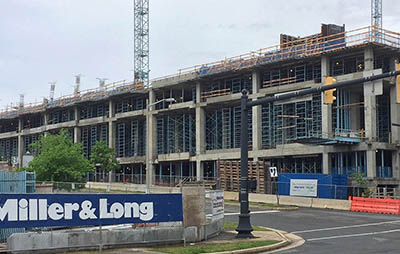
Cautious Optimism in Annual Construction Survey

Construction contractors remain cautiously optimistic a year after the industry’s post-pandemic comeback started in earnest, according to the 2022 Marcum National Construction Survey. Contractors reported being buoyed by the federal infrastructure bill, growing backlogs, and other tailwinds.
The annual survey by Marcum LLP, New York, covers a range of topics, from top priorities to problems, strategies, possible solutions and the lingering effects of the pandemic. 2022 is the third iteration of the national industry study.
Among this year’s key findings, nearly 60% of respondents said they expect more opportunity in the future, up from 54% in 2021. More than half (69%) expect the Infrastructure Investment and Jobs Act to have a positive financial impact for their businesses.
The industry’s upbeat outlook is also supported by a significant increase in backlogs, with 48% of respondents (up from 29% in 2021) reporting higher backlogs than the previous year.
“Broadly speaking, the construction industry is finally returning to pre-pandemic levels of activity but is still being hampered by three familiar challenges – labor shortages, material costs and availability, and supply chain issues,” said Roger Gingerich, a Marcum Partner who leads the Firm’s Midwest construction practice. “Most respondents are positioning for growth and looking for ways to thrive in a very dynamic space. This includes an uptick in joint ventures, something we think makes sense given the difficulties in securing skilled labor and materials in a sector where there is both high demand and deep competition.”
Other key findings:
• Construction companies reported their finances remained solid, with just 13% of respondents saying it had become more difficult to obtain financing and the majority saying their access to capital was the same or improved.
• Material price volatility remained the #1 top issue for construction company executives, followed by healthcare and insurance costs. Workers’ compensation issues jumped to No. 3, edging out income taxes.
• 95% of respondents increased worker pay to combat labor shortages. Of those, 67% offered raises of 4% or more, and 13% increased compensation by more than 8%.
• 27% percent of respondents are filling skills gaps by forming or considering joint ventures.
• The number of respondents considering an ESOP more than doubled from the prior survey, and the number of ESOP companies increased by 5%.
• Companies restructuring for growth climbed from 28% in 2021 to 40% this year. 23% of respondents said they are seeking M&A opportunities, up from 13% a year ago.
• 49% of respondents said they were working on larger projects in 2021 and just 11% reported that the average job size had decreased.
• 89% said jobs were delayed by material shortages, labor shortages, or both at some point during the year.
“Mergers & and acquisitions deal value in the global construction sector nearly doubled last year, and that mirrors what we’re seeing among our clients,” said Joseph Natarelli, national leader of Marcum’s Construction Services practice and office managing partner in New Haven, Conn. “We’re also seeing better structure around those deals, indicating increased sophistication in these transactions.”
Natarelli noted ongoing high backlogs are increasing the attractiveness of the construction sector for private equity. “Supply chain issues and material cost increases are making it more advantageous for bigger players to pool purchasing power, while shortages of skilled labor and increasing specialization are both driving consolidation within the trades,” h said. “Many construction companies are emerging from the pandemic without a succession plan, and M&A is an option for them.”
